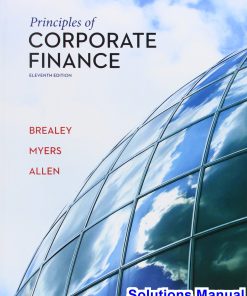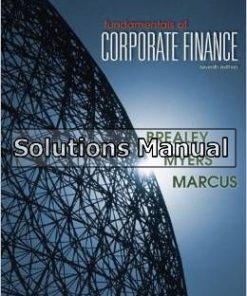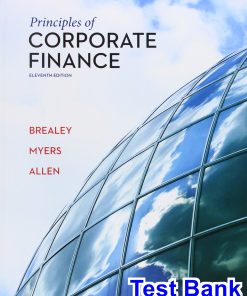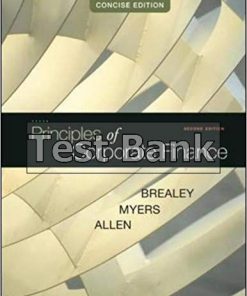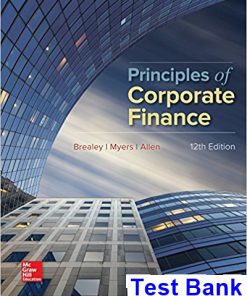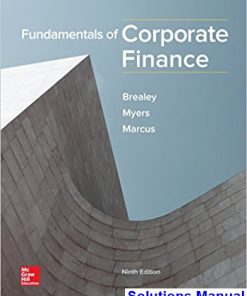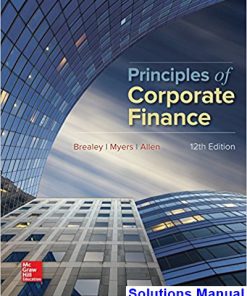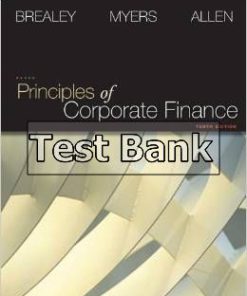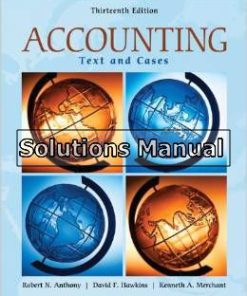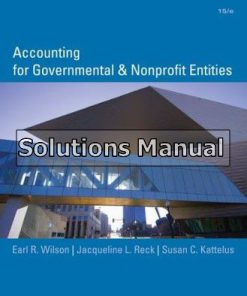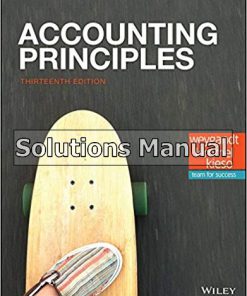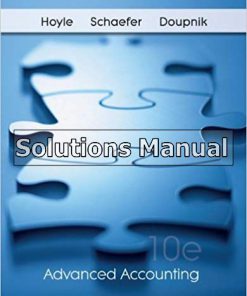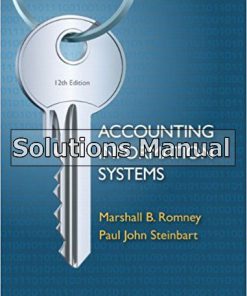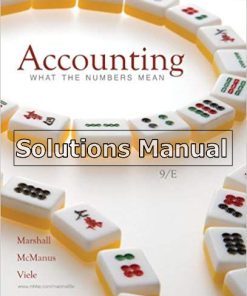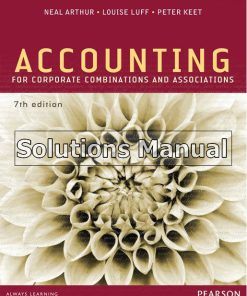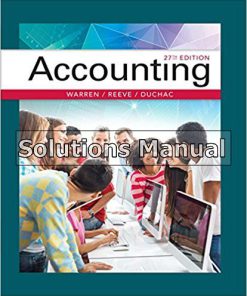Principles of Corporate Finance 10th Edition Brealey Solutions Manual
$50.00 Original price was: $50.00.$26.50Current price is: $26.50.
Principles of Corporate Finance 10th Edition Brealey Solutions Manual.
This is completed downloadable of Principles of Corporate Finance 10th Edition Brealey Solutions Manual
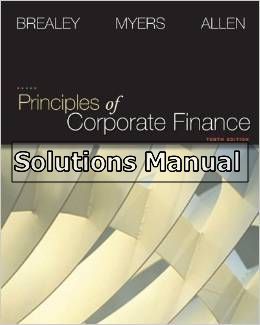
Product Details:
- ISBN-10 : 0077404890
- ISBN-13 : 978-0077404895
- Author: Richard A. Brealey (Author), Stewart C. Myers (Author), Franklin Allen (Author)
Principles of Corporate Finance is the worldwide leading text that describes the theory and practice of corporate finance. Throughout the book, the authors show how managers use financial theory to solve practical problems and as a way to respond to change by showing not just how, but why companies and management act as they do. This text is a valued reference for thousands of practicing financial managers. The Tenth Edition has been rewritten, refreshed, and fully updated to reflect the recent financial crisis and is now accompanied by Connect Finance, an exciting new homework management system.
Table of Content:
C h a p t e r 1 FINANCE AND THE FINANCIAL MANAGER 4 1.1 What Is a Corporation? 5 1.2 The Role of the Financial Manager 6 1.3 Who Is the Financial Manager? 8 1.4 Separation of Ownership and Management 9 1.5 Topics Covered in this Book 11 Summary 12 Further Reading 12 Concept Review Questions 13 Quiz 13 C h a p t e r 2 PRESENT VALUES, THE OBJECTIVES OF THE FIRM, AND CORPORATE GOVERNANCE 14 2.1 Introduction to Present Value 15 Calculating Future and Present Value / Net Present Value / Risk and Present Value / Present Values and Rates of Return / The Opportunity Cost of Capital / A Source of Confusion 2.2 Foundations of the Net Present Value Rule 20 How Capital Markets Reconcile Preferences for Current vs. Future Consumption / A Fundamental Result / Other Corporate Goals 2.3 Corporate Goals and Corporate Governance 25 Should Managers Look after the Interests of Shareholders? / Should Firms Be Managed for Shareholders or All Stakeholders? Summary 28 Further Reading 30 Concept Review Questions 30 Quiz 30 Practice Questions 31 Challenge Questions 32 C h a p t e r 3 HOW TO CALCULATE PRESENT VALUES 34 3.1 Valuing Long-Lived Assets 35 Valuing Cash Flows in Several Periods / Why the Discount Factor Declines As Futurity Increases? And a Digression on Money Machines / Calculating PVs and NPVs 3.2 Looking for Shortcuts?Perpetuities and Annuities 39 How to Value Growing Perpetuities / How to Value Annuities 3.3 Compound Interest and Present Values 44 A Note on Compounding Intervals / Continuous Compounding 3.4 Nominal and Real Rates of Interest 49 Summary 50 Web Exercises 51 Concept Review Questions 52 Quiz 52 Practice Questions 53 Challenge Questions 55 C h a p t e r 4 THE VALUE OF BONDS AND COMMON STOCKS 56 4.1 Using Present Value Formulas to Value Bonds 57 A Short Trip to Germany to Value a Government Bond / What Happens When Interest Rates Change? / Back in the United States: Semiannual Coupons and Bond Prices 4.2 How Common Stocks Are Traded 60 4.3 How Common Stocks Are Valued 61 Today?s Price / But What Determines Next Year?s Price? 4.4 Estimating the Cost of Equity Capital 65 Using the DCF Model to Set Gas and Electricity Prices / Some Warnings about Constant-Growth Formulas / DCF Valuation with Varying Growth Rates 4.5 The Link between Stock Price and Earnings per Share 72 Calculating the Present Value of Growth Opportunities for Fledgling Electronics / Some Examples of Growth Opportunities? Summary 76 Further Reading 77 Concept Review Questions 78 Quiz 78 Practice Questions 79 Challenge Questions 81 Mini-case: Reeby Sports 82 C h a p t e r 5 WHY NET PRESENT VALUE LEADS TO BETTER INVESTMENT DECISIONS THAN OTHER CRITERIA 84 5.1 A Review of the Basics 85 Net Present Value?s Competitors / Three Points to Remember about NPV / NPV Depends on Cash Flow, Not on Book Returns 5.2 Payback 89 The Payback Rule 5.3 Internal (or Discounted-Cash-Flow) Rate of Return 91 Calculating the IRR / The IRR Rule / Pitfall 1?Lending or Borrowing? / Pitfall 2?Multiple Rates of Return / Pitfall 3?Mutually Exclusive Projects / Pitfall 4?What Happens When We Can?t Finesse the Term Structure of Interest Rates? / The Verdict on IRR 5.4 Choosing Capital Investments When Resources Are Limited 100 An Easy Problem in Capital Rationing / Uses of Capital Rationing Models Summary 103 Further Reading 104 Concept Review Questions 105 Quiz 105 Practice Questions 106 Challenge Questions 108 Mini-case: Vegetron?s CFO Calls Again 109 C h a p t e r 6 MAKING INVESTMENT DECISIONS WITH THE NET PRESENT VALUE RULE 112 6.1 What to Discount 113 Only Cash Flow Is Relevant / Estimate Cash Flows on an Incremental Basis / Treat Inflation Consistently 6.2 Example?IM&C?S Fertilizer Project 118 Separating Investment and Financing Decisions / Investments in Working Capital / A Further Note on Depreciation / A Final Comment on Taxes / Project Analysis / Calculating NPV in Other Countries and Currencies 6.3 Equivalent Annual Costs 125 Investing to Produce Reformulated Gasoline at California Refineries / Choosing between Long- and Short-Lived Equipment / Deciding When to Replace an Existing Machine / Cost of Excess Capacity 6.4 Project Interactions 130 Case 1: Optimal Timing of Investment / Case 2: Fluctuating Load Factors Summary 133 Concept Review Questions 134 Quiz 134 Practice Questions 136 Challenge Questions 140 Mini-case: New Economy Transport (A) and (B) 141 P a r t T w o RISK 144 C h a p t e r 7 INTRODUCTION TO RISK, RETURN, AND THE OPPORTUNITY COST OF CAPITAL 146 7.1 Over a Century of Capital Market History in One Easy Lesson 147 Arithmetic Averages and Compound Annual Returns / Using Historical Evidence to Evaluate Today?s Cost of Capital / An Alternative Measure of the Risk Premium 7.2 Measuring Portfolio Risk 154 Variance and Standard Deviation / Measuring Variability / How Diversification Reduces Risk 7.3 Calculating Portfolio Risk 163 General Formula for Computing Portfolio Risk / Limits to Diversification 7.4 How Individual Securities Affect Portfolio Risk 167 Market Risk Is Measured by Beta / Why Security Betas Determine Portfolio Risk 7.5 Diversification and Value Additivity 171 Summary 172 Further Reading 173 Concept Review Questions 173 Quiz 174 Practice Questions 175 Challenge Questions 178 C h a p t e r 8 RISK AND RETURN 180 8.1 Harry Markowitz and the Birth of Portfolio Theory 181 Combining Stocks into Portfolios / We Introduce Borrowing and Lending 8.2 The Relationship between Risk and Return 188 Some Estimates of Expected Returns / Review of the Capital Asset Pricing Model / What If a Stock Did Not Lie on the Security Market Line? 8.3 Validity and Role of the Capital Asset Pricing Model 192 Tests of the Capital Asset Pricing Model / Assumptions behind the Capital Asset Pricing Model 8.4 Some Alternative Theories 197 Consumption Betas versus Market Betas / Arbitrage Pricing Theory / A Comparison of the Capital Asset Pricing Model and Arbitrage Pricing Theory / APT Example / The Three-Factor Model Summary 204 Further Reading 206 Concept Review Questions 206 Quiz 206 Practice Questions 208 Challenge Questions 212 C h a p t e r 9 CAPITAL BUDGETING AND RISK 214 9.1 Company and Project Costs of Capital 215 Perfect Pitch and the Cost of Capital / Debt and the Company Cost of Capital 9.2 Measuring the Cost of Equity 219 Estimating Beta / The Expected Return on Union Pacific Corporation?s Common Stock 9.3 Setting Discount Rates When You Do Not Have a Beta 222 Avoid Fudge Factors in Discount Rates / What Determines Asset Betas? 9.4 Certainty Equivalents?Another Way of Adjusting for Risk 226 Valuation by Certainty Equivalents / When to Use a Single Risk-Adjusted Discount Rate for Long-Lived Assets / A Common Mistake / When You Cannot Use a Single Risk-Adjusted Discount Rate for Long-Lived Assets 9.5 Discount Rates for International Projects 231 Foreign Investments Are Not Always Riskier / Foreign Investment in the United States / Do Some Countries Have a Lower Cost of Capital? Summary 234 Further Reading 235 Concept Review Questions 235 Quiz 235 Practice Questions 236 Challenge Questions 239 Mini-case: The Jones Family, Incorporated 240 P a r t T h r e e PRACTICAL PROBLEMS IN CAPITAL BUDGETING 242 C h a p t e r 10 A PROJECT IS NOT A BLACK BOX 244 10.1 Sensitivity Analysis 245 Value of Information / Limits to Sensitivity Analysis / Scenario Analysis / Break-Even Analysis / Operating Leverage and Break-Even Points 10.2 Monte Carlo Simulation 253 Simulating the Electric Scooter Project / Simulation of Pharmaceutical Research and Development 10.3 Real Options and Decision Trees 257 The Option to Expand / The Option to Abandon / Two Other Real Options / More on Decision Trees / An Example: Magna Charter / Pro and Con Decision Trees / Decision Trees and Monte Carlo Simulation Summary 267 Further Reading 268 Concept Review Questions 268 Quiz 268 Practice Questions 269 Challenge Questions 271 Mini-case: Waldo County 271 C h a p t e r 11 STRATEGY AND THE CAPITAL INVESTMENT DECISION 274 11.1 Look First to Market Values 275 The Cadillac and the Movie Star / Example: Investing in a New Department Store / Another Example: Opening a Gold Mine 11.2 Economic Rents and Competitive Advantage 280 How One Company Avoided a $100 Million Mistake 11.3 Example: Marvin Enterprises Decides to Exploit a New Technology 284 Forecasting Prices of Gargle Blasters / The Value of Marvin?s New Expansion / Alternative Expansion Plans / The Value of Marvin Stock / The Lessons of Marvin Enterprises Summary 292 Further Reading 292 Concept Review Questions 292 Quiz 292 Practice Questions 293 Challenge Questions 295 Mini-case: Ecsy-Cola 297 C h a p t e r 12 AGENCY PROBLEMS, MANAGEMENT COMPENSATION, AND THE MEASUREMENT OF PERFORMANCE 298 12.1 The Capital Investment Process 299 Project Authorizations / Some Investments May Not Show Up in the Capital Budget / Postaudits 12.2 Decision Makers Need Good Information 302 Establishing Consistent Forecasts / Reducing Forecast Bias / Getting Senior Management the Information That It Needs / Eliminating Conflicts of Interest 12.3 Incentives 304 Overview: Agency Problems in Capital Budgeting / Monitoring / Providing Incentives for Managers / Management Compensation 12.4 Measuring and Rewarding Performance: Residual Income and EVA 309 Pros and Cons of EVA 12.5 Biases in Accounting Measures of Performance 314 Example: Measuring the Profitability of the Nodhead Supermarket 12.6 Measuring Economic Profitability 316 Do the Biases Wash Out in the Long Run? / What Can We Do about Biases in Accounting Profitability Measures? / Do Managers Worry Too Much about Book Profitability? Summary 321 Further Reading 322 Concept Review Questions 322 Quiz 323 Practice Questions 324 Challenge Questions 325 P a r t F o u r FINANCING DECISIONS AND MARKET EFFICIENCY 328 C h a p t e r 13 CORPORATE FINANCING AND THE SIX LESSONS OF MARKET EFFICIENCY 330 13.1 We Always Come Back to NPV 332 Differences between Investment and Financing Decisions 13.2 What Is an Efficient Market? 333 A Startling Discovery: Price Changes Are Random / Three Forms of Market Efficiency / Efficient Markets: The Evidence 13.3 Puzzles and Anomalies?What Do They Mean for the Financial Manager? 342 Do Investors Respond Slowly to New Information? / Stock Market Anomalies and Behavioral Finance / Irrational Exuberance and the Dot.com Bubble / The Dot.com Boom and Relative Efficiency / Market Anomalies and the Financial Manager 13.4 The Six Lessons of Market Efficiency 349 Lesson 1: Markets Have No Memory / Lesson 2: Trust Market Prices / Lesson 3: Read the Entrails / Lesson 4: There Are No Financial Illusions / Lesson 5: The Do-It-Yourself Alternative / Lesson 6: Seen One Stock, Seen Them All Summary 354 Further Reading 355 Concept Review Questions 355 Quiz 356 Practice Questions 357 Challenge Questions 359 C h a p t e r 14 AN OVERVIEW OF CORPORATE FINANCING 360 14.1 Patterns of Corporate Financing 361 Do Firms Rely Too Much on Internal Funds? / How Much Do Firms Borrow? 14.2 Common Stock 366 Ownership of the Corporation / Voting Procedures and the Value of Votes / Equity in Disguise / Preferred Stock 14.3 Debt 372 Debt Comes in Many Forms / Variety?s the Very Spice of Life 14.4 Financial Markets and Institutions 375 Financial Institutions Summary 378 Further Reading 379 Web Exercises 379 Concept Review Questions 379 Quiz 379 Practice Questions 380 Challenge Question 381 C h a p t e r 15 HOW CORPORATIONS ISSUE SECURITIES 382 15.1 Venture Capital 383 The Venture Capital Market 15.2 The Initial Public Offering 387 Arranging an Initial Public Offering / The Sale of Marvin Stock / The Underwriters / Costs of a New Issue / Underpricing of IPOs 15.3 Other New-Issue Procedures 394 Types of Auctions 15.4 Security Sales by Public Companies 396 General Cash Offers / International Security Issues / The Costs of a General Cash Offer / Market Reaction to Stock Issues / Rights Issues 15.5 Private Placements and Public Issues 403 Summary 403 Appendix: Marvin?s New-Issue Prospectus 404 Further Reading 408 Web Exercises 408 Concept Review Questions 408 Quiz 409 Practice Questions 410 Challenge Questions 411 P a r t F i v e PAYOUT POLICY AND CAPITAL STRUCTURE 412 C h a p t e r 16 PAYOUT POLICY 414 16.1 The Choice of Payout Policy 415 16.2 Dividend Payments and Stock Repurchases 416 How Dividends Are Paid / How Firms Repurchase Stock 16.3 How Do Companies Decide on the Payout 418 16.4 The Information in Dividends and Stock Repurchases 419 The Information Content of Share Repurchase 16.5 The Payout Controversy 422 Dividend Policy Is Irrelevant in Perfect Capital Markets / Dividend Irrelevance?An Illustration / Calculating Share Price / Share Repurchase / Stock Repurchase and Valuation 16.6 The Rightists 427 Payout Policy, Investment Policy, and Management Incentives 16.7 Taxes and the Radical Left 429 Why Pay Any Dividends at All? / Empirical Evidence on Dividends and Taxes / The Taxation of Dividends and Capital Gains 16.8 The Middle-of-the-Roaders 435 Alternative Tax Systems Summary 436 Further Reading 437 Concept Review Questions 437 Quiz 437 Practice Questions 439 Challenge Questions 441 C h a p t e r 17 DOES DEBT POLICY MATTER? 444 17.1 The Effect of Financial Leverage in a Competitive Tax-free Economy 445 Enter Modigliani and Miller / The Law of Conservation of Value / An Example of Proposition 1 17.2 Financial Risk and Expected Returns 452 Proposition 2 / How Changing Capital Structure Affects Beta 17.3 The Weighted-Average Cost of Capital 456 Two Warnings / Rates of Return on Levered Equity?The Traditional Position / Today?s Unsatisfied Clienteles Are Probably Interested in Exotic Securities / Imperfections and Opportunities 17.4 A Final Word on the After-Tax Weighted-Average Cost of Capital 461 Union Pacific?s WACC Summary 462 Further Reading 463 Concept Review Questions 464 Quiz 464 Practice Questions 465 Challenge Questions 467 C h a p t e r 18 HOW MUCH SHOULD A FIRM BORROW? 468 18.1 Corporate Taxes 469 How Do Interest Tax Shields Contribute to the Value of Stockholders? Equity? / Recasting Pfizer?s Capital Structure / MM and Taxes 18.2 Corporate and Personal Taxes 473 18.3 Costs of Financial Distress 476 Bankruptcy Costs / Evidence on Bankruptcy Costs / Direct versus Indirect Costs of Bankruptcy / Financial Distress without Bankruptcy / Debt and Incentives / Risk Shifting: The First Game / Refusing to Contribute Equity Capital: The Second Game / And Three More Games, Briefly / What the Games Cost / Costs of Distress Vary with Type of Asset / The Trade-off Theory of Capital Structure 18.4 The Pecking Order of Financing Choices 490 Debt and Equity Issues with Asymmetric Information / Implications of the Pecking Order / The Trade-Off Theory vs. the Pecking-Order Theory?Some Recent Tests / The Bright Side and the Dark Side of Financial Slack Summary 495 Further Reading 497 Concept Review Questions 497 Quiz 498 Practice Questions 499 Challenge Questions 501 C h a p t e r 19 FINANCING AND VALUATION 502 19.1 The After-Tax Weighted-Average Cost of Capital 503 Example: Sangria Corporation / Review of Assumptions 19.2 Valuing Businesses 507 Valuing Rio Corporation / Estimating Horizon Value / WACC vs. the Flow-to-Equity Method 19.3 Using WACC in Practice 513 Some Tricks of the Trade / Mistakes People Make in Using the Weighted-Average Formula / Adjusting WACC When Debt Ratios or Business Risks Differ / Unlevering and Relevering Betas / The Importance of Rebalancing / The Modigliani-Miller Formula, Plus Some Final Advice 19.4 Adjusted Present Value 521 APV for the Perpetual Crusher / Other Financing Side Effects / APV for Businesses / APV for International Investments 19.5 Your Questions Answered 525 Summary 527 Appendix: Discounting Safe, Nominal Cash Flows 529 Further Reading 532 Concept Review Questions 532 Quiz 533 Practice Questions 534 Challenge Questions 537 P a r t S i x OPTIONS 538 C h a p t e r 20 UNDERSTANDING OPTIONS 540 20.1 Calls, Puts, and Shares 542 Call Options and Position Diagrams / Put Options / Selling Calls, Puts, and Shares / Position Diagrams Are Not Profit Diagrams 20.2 Financial Alchemy with Options 546 Spotting the Option 20.3 What Determines Option Values? 552 Risk and Option Values Summary 558 Further Reading 558 Concept Review Questions 559 Quiz 559 Practice Questions 560 Challenge Questions 562 C h a p t e r 21 VALUING OPTIONS 564 21.1 A Simple Option-Valuation Model 565 Why Discounted Cash Flow Won?t Work for Options / Constructing Option Equivalents from Common Stocks and Borrowing / Valuing the Amgen Put Option 21.2 The Binomial Method for Valuing Options 570 Example: The Two-Stage Binomial Method / The General Binomial Method / The Binomial Method and Decision Trees 21.3 The Black?Scholes Formula 575 Using the Black?Scholes Formula / The Black?Scholes Formula and the Binomial Method 21.4 Black?Scholes in Action 579 Executive Stock Options / Warrants / Portfolio Insurance / Calculating Implied Volatilities 21.5 Option Values at a Glance 582 Summary 585 Appendix: How Dilution Affects Option Value 585 Further Reading 589 Concept Review Questions 589 Quiz 589 Practice Questions 590 Challenge Questions 593 Mini-case: Bruce Honiball?s Invention 593 C h a p t e r 22 REAL OPTIONS 596 22.1 The Value of Follow-on Investment Opportunities 597 Questions and Answers about Blitzen?s Mark II / Other Expansion Options 22.2 The Timing Option 602 Valuing the Malted Herring Option / Optimal Timing for Real Estate Development 22.3 The Abandonment Option 605 The Zircon Subductor Project / Abandonment Value and Project Life / Temporary Abandonment 22.4 Flexible Production?and Another Look at Aircraft Purchase Options 610 Another Look at Aircraft Purchase Options 22.5 A Conceptual Problem? 614 Practical Challenges Summary 615 Further Reading 616 Concept Review Questions 617 Quiz 617 Practice Questions 617 Challenge Questions 619 P a r t S e v e n DEBT FINANCING 622 C h a p t e r 23 VALUING GOVERNMENT BONDS 624 23.1 Real and Nominal Rates of Interest 626 Indexed Bonds and the Real Rate of Interest / Inflation and Nominal Interest Rates / How Well Does Fisher?s Theory Explain Interest Rates? 23.2 Term Structure and Yields to Maturity 629 Yield to Maturity / Measuring the Term Structure 23.3 How Interest Rate Changes Affect Bond Prices 632 Duration and Bond Volatility / Managing Interest Rate Risk / A Cautionary Note 23.4 Explaining the Term Structure 636 The Expectations Theory / The Liquidity-Preference Theory / Introducing Inflation / Relationships between Bond Returns Summary 641 Further Reading 642 Web Exercise 642 Concept Review Questions 643 Quiz 643 Practice Questions 644 Challenge Questions 646 C h a p t e r 24 CREDIT RISK 648 24.1 The Value of Corporate Debt 649 The Difference between Safe and Risky Debt / Valuing the Default Option / Valuing Government Loan Guarantees 24.2 Bond Ratings and the Probability of Default 656 24.3 Predicting the Probability of Default 659 Credit Scoring / Market-Based Risk Models 24.4 Value at Risk 663 Summary 665 Further Reading 666 Concept Review Questions 666 Quiz 666 Practice Questions 667 Challenge Questions 667 C h a p t e r 25 THE MANY DIFFERENT KINDS OF DEBT 668 25.1 Domestic Bonds, Foreign Bonds, and Eurobonds 670 25.2 The Bond Contract 670 Indenture, or Trust Deed / The Bond Terms 25.3 Security and Seniority 673 Asset-Backed Securities 25.4 Repayment Provisions 675 Sinking Funds / Call Provisions 25.5 Debt Covenants 678 25.6 Convertible Bonds and Warrants 680 What Is a Convertible Bond? / The Value of a Convertible at Maturity / Forcing Conversion / Why Do Companies Issue Convertibles? / Valuing Convertible Bonds / Some Variations on Convertible Bonds: Mandatory Convertibles and Reverse Convertibles / A Third Variation on Convertible Bonds: The Bond-Warrant Package 25.7 Private Placements and Project Finance 686 Project Finance / Project Finance?Some Common Features / The Role of Project Finance 25.8 Innovation in the Bond Market 690 Summary 692 Further Reading 693 Concept Review Questions 693 Quiz 693 Practice Questions 694 Challenge Questions 696 Mini-case: The Shocking Demise of Mr. Thorndike 697 C h a p t e r 26 LEASING 698 26.1 What Is a Lease? 699 26.2 Why Lease? 700 Sensible Reasons for Leasing / Some Dubious Reasons for Leasing 26.3 Operating Leases 703 Example of an Operating Lease / Lease or Buy? 26.4 Valuing Financial Leases 706 Example of a Financial Lease / Who Really Owns the Leased Asset? / Leasing and the Internal Revenue Service / A First Pass at Valuing a Lease Contract / The Story So Far 26.5 When Do Financial Leases Pay? 712 Summary 713 Further Reading 714 Concept Review Questions 714 Quiz 715 Practice Questions 716 Challenge Questions 717 P a r t E i g h t RISK MANAGEMENT 718 C h a p t e r 27 MANAGING RISK 720 27.1 Why Manage Risk? 721 Reducing the Risk of Cash Shortfalls or Financial Distress / Agency Costs May Be Mitigated by Risk Management / The Evidence on Risk Management 27.2 Insurance 724 How British Petroleum (BP) Changed Its Insurance Strategy 27.3 Forward and Futures Contracts 727 A Simple Forward Contract / Futures Exchanges / The Mechanics of Futures Trading / Trading and Pricing Financial Futures Contracts / Spot and Futures Prices? Commodities / More about Forward Contracts / Homemade Forward Rate Contracts 27.4 Swaps 735 Interest Rate Swaps / Currency Swaps / Credit Derivatives 27.5 How to Set Up a Hedge 739 Using Theory to Set Up the Hedge: An Example / Options, Deltas, and Betas 27.6 Is ?Derivative? a Four-Letter Word? 743 Summary 746 Further Reading 747 Concept Review Questions 747 Quiz 748 Practice Questions 749 Challenge Questions 753 C h a p t e r 28 MANAGING INTERNATIONAL RISKS 754 28.1 The Foreign Exchange Market 755 28.2 Some Basic Relationships 757 Interest Rates and Exchange Rates / The Forward Premium and Changes in Spot Rates / Changes in the Exchange Rate and Inflation Rates / Interest Rates and Inflation Rates / Is Life Really That Simple? 28.3 Hedging Currency Risk 765 Transaction Exposure and Economic Exposure / Currency Speculation 28.4 Exchange Risk and International Investment Decisions 768 More about the Cost of Capital 28.5 Political Risk 771 Summary 773 Further Reading 774 Web Exercise 775 Concept Review Questions 775 Quiz 775 Practice Questions 776 Challenge Questions 778 Mini-case: Exacta, s.a. 779 P a r t N i n e FINANCIAL PLANNING AND THE MANAGEMENT OF WORKING CAPITAL 780 C h a p t e r 29 FINANCIAL ANALYSIS AND PLANNING 782 29.1 Financial Statements 783 29.2 Executive Paper?s Financial Statements 784 The Balance Sheet / The Income Statement / Sources and Uses of Funds 29.3 Measuring Executive Paper?s Financial Condition 789 How Much Has Executive Paper Borrowed? / How Liquid Is Executive Paper? / How Productively Is Executive Paper Using Its Assets? / How Profitable Is Executive Paper? / How Highly Is Executive Paper Valued by Investors? / The Dupont System 29.4 Financial Planning 797 29.5 Financial Planning Models 798 Pitfalls in Model Design / There Is No Finance in Financial Planning Models 29.6 Growth and External Financing 801 Summary 802 Further Reading 803 Web Exercises 804 Concept Review Questions 804 Quiz 804 Practice Questions 807 Challenge Questions 811 C h a p t e r 30 WORKING CAPITAL MANAGEMENT 812 30.1 Credit Management 814 Terms of Sale / The Promise to Pay / Credit Analysis / The Credit Decision / Collection Policy 30.2 Inventory Management 821 30.3 Cash 821 Using Cash Efficiently / Electronic Funds Transfer / International Cash Management / Paying for Bank Services 30.4 Marketable Securities 826 Calculating the Yield on Money-Market Investments / Yields on Money-Market Investments / The International Money Market / Money-Market Instruments Summary 832 Further Reading 834 Web Exercises 834 Concept Review Questions 834 Quiz 835 Practice Questions 836 Challenge Questions 838 C h a p t e r 31 SHORT-TERM FINANCIAL PLANNING 840 31.1 Links between Long-Term and Short-Term Financing Decisions 841 31.2 Tracing Changes in Cash and Working Capital 845 Tracing Changes in Net Working Capital / Profits and Cash Flow 31.3 Cash Budgeting 849 Preparing the Cash Budget: Inflow / Preparing the Cash Budget: Outflow 31.4 The Short-Term Financing Plan 852 Options for Short-Term Financing / Dynamic?s Financing Plan / Evaluating the Plan / A Note on Short- Term Financial Planning Models 31.5 Sources of Short-Term Borrowing 856 Bank Loans / Commercial Paper / Medium-Term Notes Summary 861 Further Reading 863 Web Exercise 863 Concept Review Questions 863 Quiz 863 Practice Questions 865 Challenge Questions 867 P a r t T e n MERGERS, CORPORATE CONTROL, AND GOVERNANCE 868 C h a p t e r 32 MERGERS 870 32.1 Sensible Motives for Mergers 871 Economies of Scale / Economies of Vertical Integration / Complementary Resources / Surplus Funds / Eliminating Inefficiencies / Industry Consolidation 32.2 Some Dubious Reasons for Mergers 877 To Diversify / Increasing Earnings per Share: The Bootstrap Game / Lower Financing Costs 32.3 Estimating Merger Gains and Costs 881 Right and Wrong Ways to Estimate the Benefits of Mergers / More on Estimating Costs?What If the Target?s Stock Price Anticipates the Merger? / Estimating Cost When the Merger Is Financed by Stock / Asymmetric Information 32.4 The Mechanics of a Merger 886 Mergers and Antitrust Law / The Form of Acquisition / Merger Accounting / Some Tax Considerations 32.5 Takeover Battles and Tactics 889 Boone Pickens Tries to Take Over Cities Service, Gulf Oil, and Phillips Petroleum / Takeover Defenses / AlliedSignal vs. AMP / Who Gains Most in Mergers? 32.6 Mergers and the Economy 896 Merger Waves / Do Mergers Generate Net Benefits? Summary 897 Appendix: Conglomerate Mergers and Value Additivity 898 Further Reading 900 Concept Review Questions 901 Quiz 901 Practice Questions 902 Challenge Questions 903 C h a p t e r 33 CORPORATE RESTRUCTURING 904 33.1 Leveraged Buyouts 905 RJR Nabisco / Barbarians at the Gate? / Leveraged Restructurings / LBOs and Leveraged Restructurings 33.2 Fusion and Fission in Corporate Finance 910 Spin-offs / Carve-outs / Asset Sales / Privatization 33.3 Conglomerates 915 Fifteen Years after Reading This Chapter / Financial Architecture of Traditional U.S. Conglomerates / Temporary Conglomerates 33.4 Bankruptcy 921 Is Chapter 11 Efficient? / Workouts / Alternative Bankruptcy Procedures Summary 926 Further Reading 927 Concept Review Questions 928 Quiz 929 Practice Questions 929 C h a p t e r 34 GOVERNANCE AND CORPORATE CONTROL AROUND THE WORLD 930 34.1 Financial Markets and Institutions 931 Investor Protection and the Development of Financial Markets 34.2 Ownership, Control, and Governance 936 Ownership and Control in Japan / Ownership and Control in Germany / European Boards of Directors / Ownership and Control in Other Countries / Conglomerates Revisited 34.3 Do These Differences Matter? 945 Risk and Short-termism / Growth Industries and Declining Industries / Transparency and Governance Summary 949 Further Reading 951 Concept Review Questions 951 Quiz 951 Practice Questions 952 P a r t E l e v e n CONCLUSION 955 C h a p t e r 35 CONCLUSION: WHAT WE DO AND DO NOT KNOW ABOUT FINANCE 956 35.1 What We Do Know: The Seven Most Important Ideas in Finance 957 1. Net Present Value / 2. The Capital Asset Pricing Model / 3. Efficient Capital Markets / 4. Value Additivity and the Law of Conservation of Value / 5. Capital Structure Theory / 6. Option Theory / 7. Agency Theory 35.2 What We Do Not Know: 10 Unsolved Problems in Finance 960 1. What Determines Project Risk and Present Value? / 2. Risk and Return?What Have We Missed? / 3. How Important Are the Exceptions to the Efficient-Market Theory? / 4. Is Management an Off-Balance-Sheet Liability? / 5. How Can We Explain the Success of New Securities and New Markets? / 6. How Can We Resolve the Payout Controversy? / 7. What Risks Should a Firm Take? / 8. What Is the Value of Liquidity? / 9. How Can We Explain Merger Waves? / 10. How Can We Explain International Differences in Financial Architecture? 35.3 A Final Word 967 Appendix A Present Value Tables 968 Appendix B Answers to Quizzes 974 Glossary 992 Global Index 1007 General Index 1011
People Also Search:
principles of corporate finance
principles of corporate finance 10th edition brealey
principles of corporate finance 10th edition
principles of corporate finance 10th edition download scribd
principles of corporate finance 10th edition solution manual download pdf
Instant download after Payment is complete
You may also like…
Related products
Solutions Manual
Accounting Texts and Cases 13th Edition Anthony Solutions Manual
Solutions Manual
Accounting for Governmental and Nonprofit Entities 15th Edition Wilson Solutions Manual
Solutions Manual
Accounting Principles 13th Edition Weygandt Solutions Manual
Solutions Manual
Solutions Manual
Accounting Information Systems 12th Edition Romney Solutions Manual
Solutions Manual
Solutions Manual




